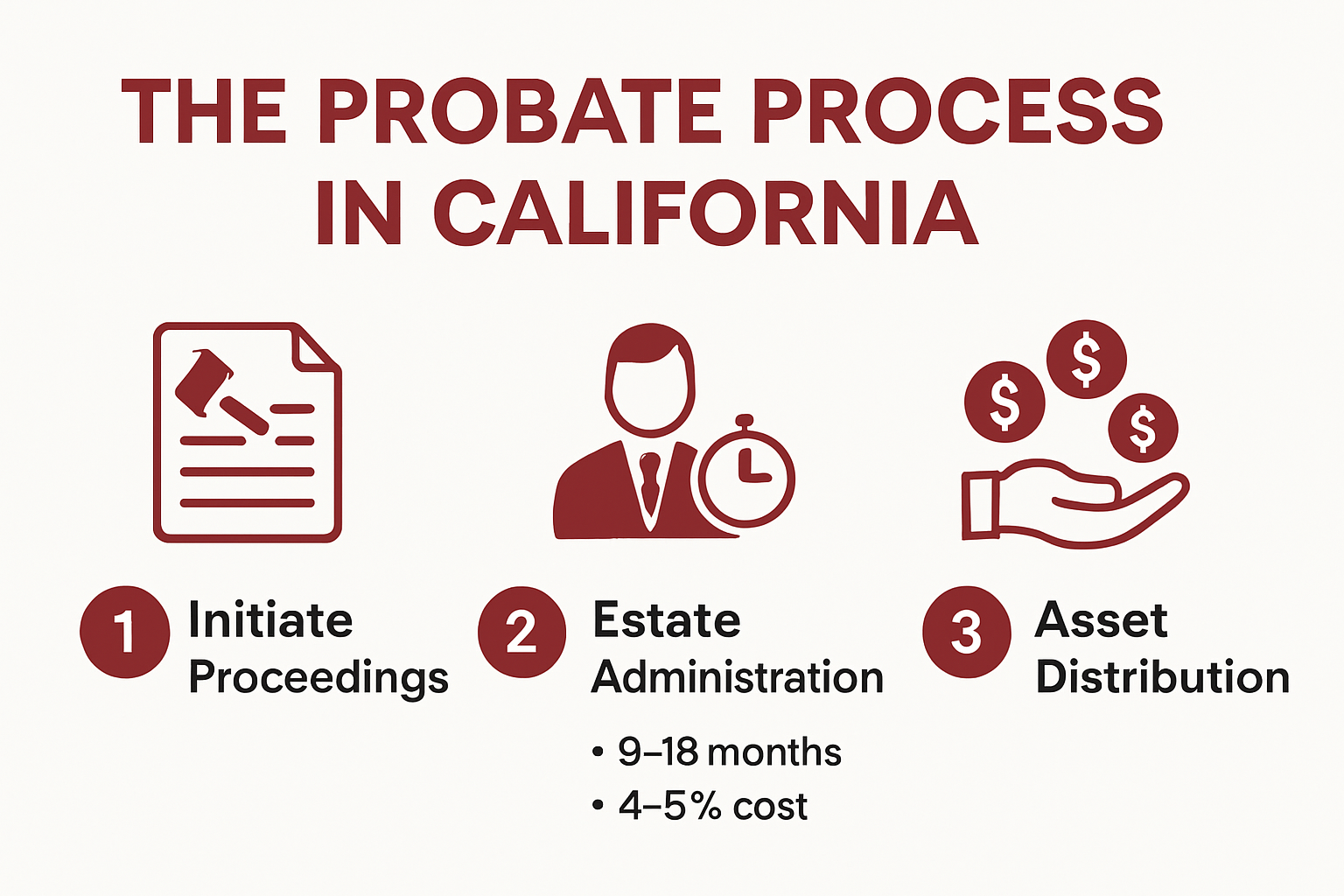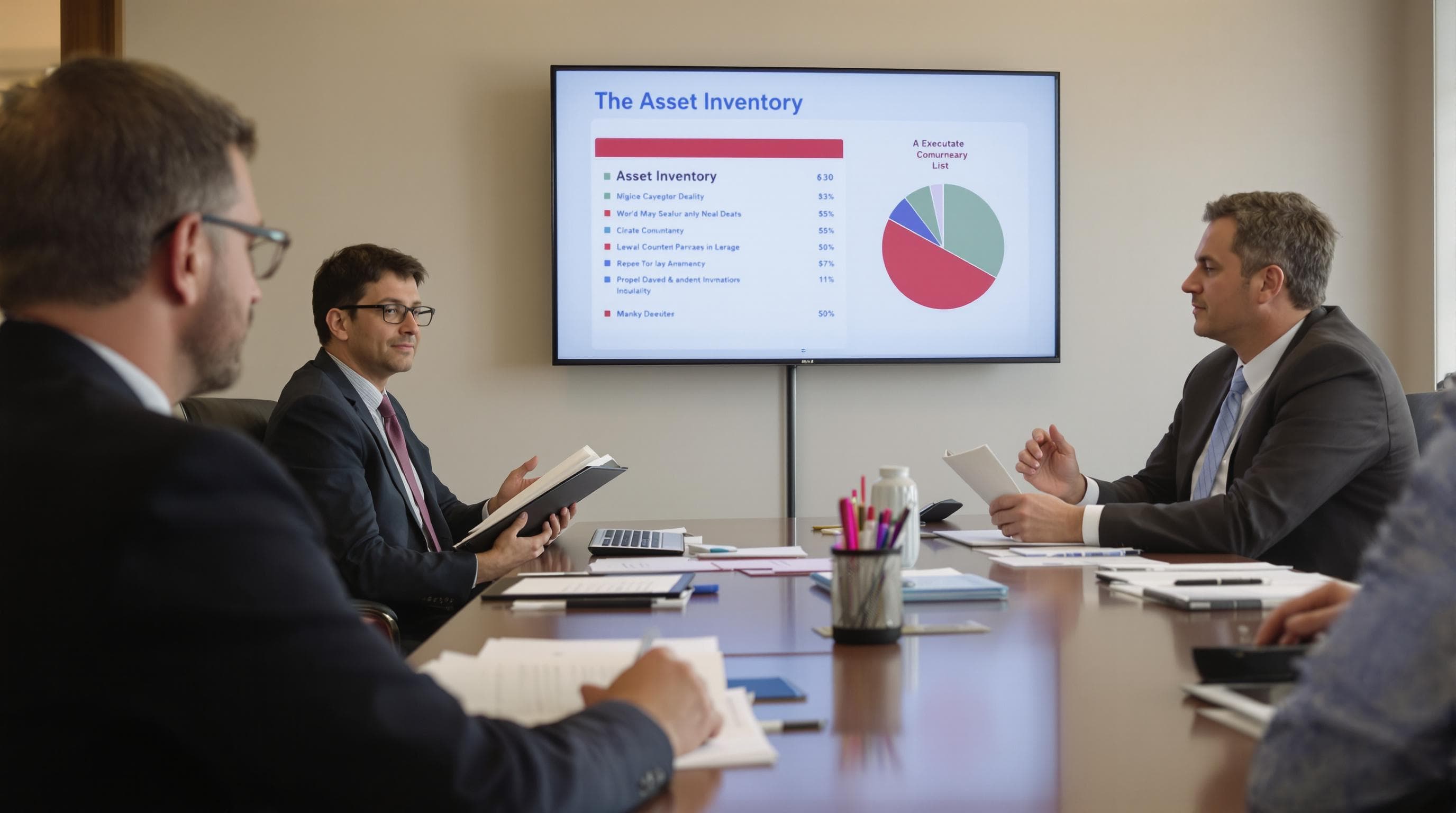
PARENTS & HOMEOWNERS: MY 7-STEP ESTATE PLANNING PROCESS WILL PROTECT YOUR HEIRS
From Creditors, Predators & Bad Choices, And Will Help You Become a (Bigger) Hero to Your Family!



Understanding Probate Process in California: 2025 Guide for Families and Homeowners
{
“@type”: “Article”,
“author”: {
“url”: “https://ridleylawoffices.com”,
“name”: “Ridley Law Offices”,
“@type”: “Organization”
},
“@context”: “https://schema.org”,
“headline”: “Understanding Probate Process in California: 2025 Guide for Families and Homeowners”,
“publisher”: {
“url”: “https://ridleylawoffices.com”,
“name”: “Ridley Law Offices”,
“@type”: “Organization”
},
“inLanguage”: “en”,
“articleBody”: “Understanding probate process in California helps families and property owners protect assets, reduce risks, and best provide for their loved ones.”,
“description”: “Understanding probate process in California helps families and property owners protect assets, reduce risks, and best provide for their loved ones.”,
“datePublished”: “2025-07-23T02:51:51.883Z”,
“mainEntityOfPage”: {
“@id”: “https://ridleylawoffices.com/understanding-probate-process-california-2025”,
“@type”: “WebPage”
}
}
California probate can be a tangled web for families hoping to keep their home and wealth safe after losing a loved one. Most people are shocked to learn that the average probate process in California takes anywhere from nine months to over a year and can cost up to 5% of the estate’s total value in fees and expenses. But the real surprise is this does not just drain money. It can also stir up serious family conflicts and expose personal finances to the public, unless you know the steps to sidestep common mistakes and protect what matters most.
Table of Contents
- What probate means for california families
- Step-by-step overview of the probate process
- Common mistakes and how to avoid probate pitfalls
- Smart planning to protect children and wealth
Quick Summary
| Takeaway | Explanation |
|---|---|
| Understand the probate process fully | Familiarize yourself with each stage of probate to navigate the legal requirements effectively. |
| Avoid common probate mistakes | Ensure thorough documentation and clear asset distribution plans to prevent legal complications. |
| Be proactive in estate planning | Regularly update legal documents to adapt to changes in family dynamics and financial situations. |
| Establish clear guardianship and financial protections | Create structured plans to support children and safeguard family wealth in case of unforeseen events. |
| Seek professional guidance when needed | Consult with legal experts to effectively manage the complexities of probate and estate planning. |
What Probate Means for California Families
Probate represents a critical legal process that impacts how families transfer assets and manage an estate after a loved one passes away. For California families, understanding probate is not just a legal requirement but a crucial step in protecting their financial legacy and navigating complex inheritance challenges.
The Legal Framework of Probate in California
The probate process in California serves as a court-supervised mechanism for managing a deceased person’s estate. According to the California Judicial Branch, probate involves identifying and gathering the assets of a deceased person, paying outstanding debts, and distributing the remaining property to heirs or beneficiaries. This process becomes necessary when an individual owned assets solely in their name without alternative transfer mechanisms like living trusts or joint ownership.
For many California families, probate can be an emotionally and financially challenging experience. The process typically requires extensive documentation, court appearances, and potential legal representation. Research from the State Bar of California highlights that probate can involve significant court fees and attorney costs, with the entire process potentially lasting several months to over a year.
Financial and Emotional Implications for Families
The probate process introduces several critical considerations for California families. Financial implications include potential estate taxes, court fees, and legal expenses that can substantially reduce the overall inheritance. Emotional challenges arise from the public nature of probate proceedings, which can expose family financial details and potentially create tensions among potential beneficiaries.
Understanding these complexities is why many families seek alternatives to traditional probate. Learn more about navigating California probate complexities to protect your family’s financial interests and minimize potential conflicts.
Key challenges families encounter during probate include:
- Asset Valuation: Accurately determining the value of estate assets
- Creditor Claims: Managing and resolving outstanding financial obligations
- Distribution Challenges: Ensuring fair and legal asset distribution among heirs
The comparative overview from the Connecticut General Assembly’s research emphasizes that probate serves a critical protective function for beneficiaries and creditors by providing supervised asset distribution. However, the process can be complex and time-consuming, requiring careful navigation and potentially professional legal guidance.
For California families, probate represents more than a legal procedure. It is a crucial process that determines how a lifetime of accumulated assets will be transferred to the next generation. Successful probate management requires understanding legal requirements, maintaining clear documentation, and potentially exploring strategies to minimize court involvement and associated costs.
While the probate process can seem overwhelming, knowledgeable preparation and professional guidance can transform it from a daunting challenge into a manageable legal procedure that honors a loved one’s final wishes and protects the family’s financial future.

Step-by-Step Overview of the Probate Process
Navigating the probate process requires understanding a complex legal journey that transforms a deceased person’s estate from private ownership to legal distribution. For California families, this process involves multiple critical stages that demand careful attention and strategic planning.
Initiating the Probate Proceedings
The probate process begins with filing a petition in the superior court where the deceased person resided. According to the California Courts Self-Help Guide, this initial step involves several crucial elements. The executor named in the will or an administrator appointed by the court must submit the original will, a certified copy of the death certificate, and a comprehensive petition to open probate.
Key initial requirements include:
- Petition Filing: Submitting legal documents to the appropriate county court
- Executor Verification: Confirming the legal authority of the estate representative
- Asset Inventory: Preparing a detailed list of all deceased assets
Estate Administration and Asset Management
Once the court validates the petition, the executor receives legal authorization to manage the estate. Additional guidance from the California Courts emphasizes the complexity of this stage. The executor must notify all potential beneficiaries and creditors, conduct a thorough inventory of assets, and obtain professional appraisals for significant property and investments.
Explore our comprehensive guide to estate settlement to understand the intricate details of this critical phase. Asset management includes:
- Protecting and maintaining estate property
- Paying outstanding debts and taxes
- Managing financial accounts and investments
- Resolving potential creditor claims
Final Distribution and Estate Closure
The final stage of probate involves distributing remaining assets to beneficiaries and formally closing the estate. This process requires meticulous documentation and court approval. The executor must provide a comprehensive accounting of all financial transactions, asset distributions, and remaining estate value.
Critical closure steps include:
- Preparing a final accounting report
- Obtaining court approval for asset distribution
- Transferring assets to designated beneficiaries
- Filing final tax returns
- Officially closing the probate case
The entire probate process in California can range from several months to over a year, depending on the estate’s complexity, potential disputes, and court schedules. Families should approach probate with patience, thorough documentation, and potentially professional legal guidance to navigate this challenging terrain effectively.

Understanding each step helps families anticipate potential challenges, reduce stress, and ensure a smoother transition of assets. While the process may seem overwhelming, systematic preparation and clear communication can transform probate from a daunting legal requirement into a manageable process that honors the deceased’s final wishes and protects the family’s financial interests.
To clarify the stages involved, the following table provides an at-a-glance overview of the key steps in the California probate process and their primary activities.
| Stage | Key Activities |
|---|---|
| Initiating Probate | – Filing petition in county court – Verifying executor/administrator – Preparing asset inventory |
| Administration & Asset Management | – Notifying beneficiaries/creditors – Inventorying & appraising assets – Settling debts and taxes |
| Final Distribution & Estate Closure | – Preparing accounting report – Court approval of distributions – Transferring assets & closing case |
Common Mistakes and How to Avoid Probate Pitfalls
Navigating the probate process can be fraught with potential errors that can significantly complicate estate settlement and drain family resources. Understanding these common mistakes is crucial for California families seeking to protect their financial legacy and minimize legal complications.
Inadequate Estate Documentation
One of the most critical probate pitfalls stems from incomplete or outdated estate documentation. According to the California Courts’ Self-Help Guide, proper documentation is the foundation of a smooth probate process. Many families make the grave mistake of leaving incomplete or ambiguous documentation, which can lead to extended legal battles and significant financial strain.
Common documentation errors include:
- Outdated Will: Failing to update estate documents after major life changes
- Incomplete Asset Inventory: Not maintaining a comprehensive list of assets and liabilities
- Missing Beneficiary Designations: Neglecting to specify clear beneficiary information
Learn how to avoid critical estate planning mistakes to protect your family’s financial future and minimize potential legal complications.
Mismanagement of Estate Assets
Executors and administrators often encounter challenges in properly managing estate assets during the probate process. This stage requires meticulous financial oversight and strategic decision making. Potential mistakes can include improper asset valuation, failed tax compliance, and inappropriate asset management.
Key risks in asset management include:
- Failing to obtain professional appraisals
- Mishandling tax obligations
- Inadequate protection of estate property
- Delayed or incorrect asset distribution
Professional guidance becomes critical in navigating these complex financial landscapes. Executors must maintain detailed records, understand legal responsibilities, and act with utmost financial prudence.
Complex Family Dynamics and Legal Challenges
Family disputes can transform a straightforward probate process into a protracted legal battle. Potential conflicts arise from unclear instructions, perceived inequitable asset distribution, or challenges to the will’s validity. These disputes can result in significant emotional and financial costs for families.
Common sources of family conflict during probate include:
- Contested will provisions
- Disagreements about asset distribution
- Challenges to the executor’s competence
- Disputes over inheritance percentages
Mitigating these risks requires transparent communication, clear legal documentation, and potentially professional mediation. Families should prioritize open dialogue and consider professional legal guidance to navigate potential conflicts.
Understanding and anticipating these common probate pitfalls can transform a potentially challenging process into a manageable legal procedure. Proactive planning, comprehensive documentation, and professional guidance are key to protecting your family’s financial interests and honoring the final wishes of your loved ones.
While probate can seem overwhelming, careful preparation and strategic approach can help families navigate this complex legal landscape with confidence and minimal stress. By recognizing potential mistakes and implementing preventative strategies, California families can ensure a smoother, more efficient estate settlement process.
The table below summarizes the most common probate mistakes outlined above and the strategies to avoid them.
| Common Mistake | Description | How to Avoid |
|---|---|---|
| Inadequate Estate Documentation | Outdated wills, poor asset lists, missing designations | Keep all documents current and complete |
| Mismanagement of Estate Assets | Failing to appraise, mishandling taxes or distributions | Use professionals, document finances |
| Family Disputes & Legal Issues | Contested wills, beneficiary disagreements | Use clear documentation, open dialogue |
Smart Planning to Protect Children and Wealth
Protecting children and preserving family wealth requires strategic estate planning that goes beyond traditional probate considerations. California families must develop comprehensive approaches that safeguard both financial assets and their children’s future well-being.
Establishing Guardianship and Financial Protections
According to the California Attorney General’s Office, creating robust legal mechanisms for guardianship and asset management is crucial for families with minor children. Parents must carefully select guardians who align with their values and can provide emotional and financial stability in their absence.
Key considerations for guardianship planning include:
- Comprehensive Guardian Selection: Identifying individuals who share family values
- Financial Provisions: Creating trusts that provide structured financial support
- Age-Appropriate Asset Distribution: Designing inheritance mechanisms that protect children from premature financial access
Discover strategies for comprehensive children’s protection to ensure your family’s long-term security and well-being.
Strategic Wealth Preservation Techniques
The California Department of Financial Protection and Innovation emphasizes that effective estate planning extends beyond wealth transfer. Families must implement sophisticated strategies that protect assets from potential legal challenges, taxation, and unexpected financial disruptions.
Advanced wealth preservation strategies include:
- Creating irrevocable trusts
- Implementing multi-generational planning mechanisms
- Establishing precise asset distribution guidelines
- Developing tax-efficient inheritance structures
Legal Documentation and Future-Proofing
Comprehensive estate planning requires meticulous legal documentation that anticipates potential future scenarios. The California Courts Self-Help Guide recommends regularly updating estate documents to reflect changing family dynamics, financial circumstances, and legal requirements.
Critical documentation elements include:
- Detailed living wills
- Comprehensive power of attorney designations
- Explicit healthcare directives
- Flexible trust structures
Successful estate planning represents a dynamic process that demands continuous evaluation and adjustment. Families must remain proactive, understanding that protecting children and wealth requires more than static legal documents.
By implementing strategic planning approaches, California families can create robust frameworks that provide financial security, emotional stability, and clear guidance for future generations. The goal extends beyond mere asset transfer it involves crafting a comprehensive legacy that supports and empowers children while preserving accumulated family wealth.
Navigating these complex legal and financial landscapes requires professional guidance, careful consideration, and a forward-thinking approach. Families who invest time and resources in comprehensive estate planning can provide their children with invaluable protection and opportunities, transforming potential uncertainty into a structured, secure future.
Frequently Asked Questions
What is the probate process in California?
The probate process in California is a court-supervised procedure for managing a deceased person’s estate. It involves identifying and gathering assets, paying debts, and distributing remaining property to heirs.
How long does the probate process typically take in California?
The average probate process in California can take anywhere from nine months to over a year, depending on the complexity of the estate and any disputes that may arise.
What are common mistakes to avoid during probate?
Common mistakes include inadequate estate documentation, mismanagement of estate assets, and failing to address complex family dynamics. It’s crucial to maintain clear records and communication to prevent legal complications.
How can families protect their wealth during the probate process?
Families can protect their wealth by establishing proper estate planning techniques such as trusts, ensuring comprehensive documentation, and regularly updating legal documents to reflect changing circumstances.
Take Control of Probate and Protect What Matters Most
Dealing with California probate is stressful for families. The process is often slow and costly, and missteps in documentation or planning can cause serious delays, family disputes, and even a loss of wealth. These challenges are real, and if you have read this guide, you know how quickly an estate can become tangled in court bureaucracy. The answer is not just being informed—it is about having the right legal partner nearby. Explore solutions and strategies with our Probate resources, designed to help you avoid those common probate pitfalls and safeguard your family’s legacy.

If you are ready to move beyond worry and uncertainty, now is the best time to act. Start a conversation with Eric Ridley and his team. We focus exclusively on probate and estate planning, guiding California families to the security, clarity, and peace of mind they need. Find your next step at https://ridleylawoffices.com—or tap into our wider Estate Planning support for complete protection of your assets and your loved ones.
Recommended
- California Probate Process Explained: 2025 Guide for Families and Homeowners – Law Office of Eric Ridley
- A Step-by-Step Guide to Probate in California – Law Office of Eric Ridley
- Probate Timeline in California: What Families Need to Know in 2025 – Law Office of Eric Ridley
- How Probate Works in California: What Families Need to Know in 2025 – Law Office of Eric Ridley
